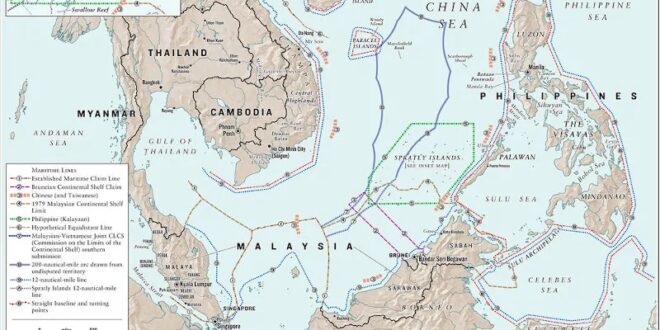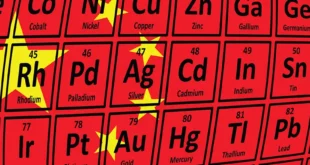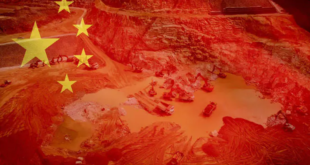Irregular warfare (IW) is a method available for Great Powers to shape or control the global architecture by enabling a state to “influence populations and affect legitimacy” without incurring the heavier losses of blood and treasure typically associated with armed conflict.1 The past decades have witnessed the rise of the People’s Republic of China (PRC) as a Great Power and its orchestration of an integrated maritime campaign using IW—for example, economic coercion, diplomatic intimidation, lawfare, and hacking of information technology systems—to control the South China Sea (SCS). This essay examines this maritime campaign’s IW tactics and describes how the United States can launch an effective countercampaign to reestablish order in the SCS by creating a surveillance network and strengthening regional security institutions.
This integrated maritime campaign is driven by a struggle between China and its neighbors for legitimacy of territorial claims over various surface and subsurface maritime terrains and a desire to manage those operations to prevent U.S. intervention (see map).2 The risk that China faces if the balance is not properly maintained is a loss of territorial claims, blood, and treasure. At the moment, China does not want to take that risk. The PRC’s integrated maritime campaign seeks to attain de jure control, or the official legal recognition of sovereign rights over China’s claims in the SCS, while remaining below the threshold of armed conflict.3 If the PRC is to fulfill this goal, it must first achieve de facto control—or a state of affairs that is true in fact if not in official law.4 Control of the SCS would provide China with maritime trade security, in-depth defense of its mainland, and greater hydrocarbon production.
Maritime trade is a part of international trade, and control of the SCS would allow China to safeguard a significant percentage of its global imports and exports.5 Specifically, the Center for Strategic and International Studies estimated in 2019 that 64 percent of China’s trade by volume transits the SCS.6 Trade route security is mutually supported by territorial security, and control of the SCS would offer China the defensive offset it desires to secure its mainland.7 The PRC’s construction of military airfields and port facilities on the maritime claims constitutes the building blocks of a mutually supporting network of military bases, logistics facilities, and supply nodes.8 By controlling the SCS through territorial security, China will gain massive hydrocarbon reserves with major oil and gas fields.9 A U.S. Geological Service study estimated that the SCS is a major oil field that contains at least 750 million barrels of oil and even more natural gas.10 The benefits to trade, defense, and resource production from controlling the SCS are nested within the PRC’s strategic core interests of security, sovereignty, and development.11
To control the SCS, China must first overcome two glaring problems: possession of a claim and the nature of the sea. The first problem is one of simple logic: If the Chinese are going to assert their sovereignty over a territorial claim, then they must have a territorial claim to start the process, and this is the raison d’être of the nine-dash line. Introduced in 1947 as the 11-dash line by Yang Huairen, an oceanic cartographer in the employ of the Nationalist Koumintang, this marker was developed based on Yang’s interpretation of underwater geography.12 Ever the opportunist, Mao Zedong adopted the claim for the PRC, but in 1952 he renounced claims to the Gulf of Tonkin as a show of proletarian solidarity with Ho Chi Minh. The removal of those two dashes produced the nine-dash line that is the foundation of present-day Chinese territorial claims.13
The second problem for China is determining how to assert control over a space that is constantly shifting form. Joseph Strange stated that a center of gravity is the “primary source of moral or physical strength, power, and resistance,” as it exists within a specific context.14 The Chinese cannot assert their sovereignty claims if they do not possess the means to control a maritime terrain feature, and they cannot control it if they cannot persist in its vicinity. Persistence, therefore, is the essential task that allows China to identify interlopers, undertake mass intimidation efforts, and exercise escalatory options. If the Chinese lose their means to persist, they will no longer have the means to achieve their ultimate purpose. In the context of the PRC’s maritime operations, the center of gravity is the service that can best accomplish the essential task of persisting on the sea.
Before we can analyze the maritime operations’ center of gravity, we must first understand the Chinese military’s perspective. In 2013, a retired People’s Liberation Army Navy (PLAN) admiral, Zhang Zhaozhong, while serving as a professor at China’s National Defense University, unofficially referred to the concept as a “cabbage strategy.”15 He equated the cabbage—with its core surrounded by layers of leaves—with a contested terrain feature surrounded by layers of maritime forces.
The PRC’s three maritime services all play important roles in the campaign, but only one possesses the capabilities to best accomplish the essential task. The first layer is the PLAN; its technologically advanced warships facilitate command and control and provide an escalatory option of the threat or actual use of military force. The second layer, created in 2013 from an amalgamation of the Fisheries Law Enforcement and the China Maritime Service, is the People’s Armed Police Force Coast Guard Corps (Chinese coast guard, or CCG).16 Both PLAN and CCG ships have the trained personnel and necessary equipment to replenish at sea, and both are valuable commodities that must prioritize other mission sets. The continuous stationing of one or more of these ships in vicinity of a contested terrain feature is not an economical use of resources, and the PRC has a better option.
The third layer is the People’s Armed Forces Maritime Militia (PAFMM). This service does not possess the same mission limitations as the PLAN and the CCG, but, like the other two services, it is able to replenish at sea, albeit limitedly, in the form of transshipment.17 Transshipment is the process of moving cargo from one vessel to another,18 and a PAFMM vessel under the guise of fishing will exchange personnel, replenish stores, and often transfer an actual catch.19 Furthermore, the sheer size of the PAFMM facilitates a continuous stream of vessels to designated locations, thereby mitigating the limitations of vessel maintenance and crew rest. As an example of its endurance, the PAFMM has maintained a daily average of 18 ships in vicinity of Thitu Island, a contested territory with the Philippines in the Spratly Island chain, since at least December 2018.20 These capacities make the PAFMM the most appropriate of the three maritime services to accomplish the crucial task of persisting in the vicinity of a contested terrain feature.
Begun as a nautical offshoot of Mao’s militia concept, the original PAFMM had two primary tasks: provide security from attacks along the coast and facilitate incorporation of the coastal population into the greater state. The militia, in its modern form, can trace its lineage to the 1982 PRC constitution, which codified militia and military service as a “sacred” and “honorable duty.”21 In 2007, the PRC further strengthened the PAFMM’s proficiencies when it released the Militia Military Training and Evaluation Outline, a document written to transform the militias from their primary orientation on the People’s Liberation Army (PLA) to include the other Chinese armed services.22
Manning the PAFMM was made easier between 2015 and 2017. During these years, the PLA cut 300,000 soldiers as part of the plan to modernize the Chinese military, and these former soldiers were rapidly absorbed into the burgeoning ranks of the PAFMM.23 The PRC, in general, gained threefold benefits from recruiting veterans into the PAFMM. First, it meant that PAFMM training cadres gained efficiency by spending less time on instruction; veterans are already skilled in small arms marksmanship and communications. Second, the provincial governments reaped fiscal savings by allocating funds to supplement a pension instead of a full salary.24 Third, by recruiting veterans, the PRC partially neutralized a threat to the Chinese Communist Party by providing jobs to suddenly unemployed soldiers.25
As the various provincial governments were recruiting new crews, they were also expanding their PAFMM fleets. Even though the manner of equipping the PAFMM units varies by provincial government, all the ships generally fall within three classifications: repurposed CCG ships, specially designed ships, and upgraded fishing vessels. The best example of the first ship classification is the YZ-310. In May 2015, after outliving its usefulness to the CCG, the ship was stripped of its guns and transferred to Hainan’s Sansha City PAFMM unit.26 The best example of the second ship classification is also found in Hainan Province. The same year the YZ-310 was acquired, the government placed an order for vessels equipped with “mast-mounted water cannons, collision-absorbing rails, and reinforced hulls,” in addition to requirements for small arms and ammunition storage rooms.27 The third ship classification composes the majority of the PAFMM’s fleet. These ships lack the purpose-built design features of a repurposed CCG ship or Hainan’s new fleet, but they still boast upgraded communications for coordination with the PLAN and CCG, small arms weapons storage, and fire hoses to harass adversary vessels.28
The manning and equipping of the PAFMM are designed to enable its two asymmetric capabilities, which are critical to achieving persistence. The first asymmetric capability, ambiguity of purpose, is created by the appearance and obfuscation of status—both critical requirements. In terms of appearance, most PAFMM ships appear as regular fishing vessels and lack the distinctive national markings seen on PLAN or CCG ships. An article written in 2014 for China’s official military newspaper, PLA Daily, describes this deception: “Putting on camouflage [uniforms], they [the men aboard] qualify as soldiers; taking off the camouflage [uniforms], they become law-abiding fishermen.”29 The intent here is to gain a decisive advantage in decisionmaking time as a result of the increased time it takes for a foreign warship or maritime law enforcement (MLE) ship to positively identify a vessel as belonging to the PAFMM.
The PRC’s deliberate obfuscation of the PAFMM’s status as either a naval auxiliary or a fishing vessel further reinforces ambiguity of purpose. The uncertainty of how to treat the PAFMM has left other nations’ maritime forces unable to appropriately respond. If they act with force because they believe the PAFMM vessels are naval auxiliaries and lawful military objectives, they risk escalation to armed conflict and condemnation for attacking an “innocent” fishing vessel. If, instead, they act with restraint and treat the PAFMM vessel as a fishing vessel, they risk harm to their own ships. This confusion has kept other nations’ maritime forces in Boyd’s observe-orient loop and consistently unable to make decisions that lead to action.30
The second asymmetric capability, ambiguity of size, is created by the following critical requirements: lack of a publicly accessible registry and the PRC’s requirement to register only those ships over 50 tons for national defense.31 This has created a theoretical size of the PAFMM that is best summed up in one adjective: large. Unfortunately, no single definitive estimate, only a range, of the PAFMM’s size exists. At the low end is 480 vessels, which translates to the combined strength of the PLAN and CCG,32 while at the high end is 140,000 vessels from a study conducted in 1978.33 Somewhere in the middle is the most realistic estimate: 20,000 vessels.34
This estimate is derived from combining a plausible starting number, an assumption about vessels under 50 tons, and an assumption about resource availability. The first factor—a plausible starting number—is found in a June 2020 study published by the Overseas Development Institute (ODI). Researchers identified 16,995 vessels in China’s Deep-Water Fishing fleet.35 The second factor is an assumption that the PRC will allocate a percentage of vessels under 50 tons to the PAFMM. The third factor is an assumption that not every Deep-Water Fishing ship is a PAFMM vessel, and while resource rich, even China lacks the ability to train and equip every fishing vessel as a PAFMM ship. The disclaimer to an estimate of 20,000 vessels is that this number is likely the most dangerous activation level and exceeds the total vessels the PRC could surge at one time. Additional assumptions about maintenance levels, crew availability, and out-of-area fishing, among others, are required to smartly approximate the number of PAFMM vessels that would most likely receive activation orders in the event of a crisis.
Critical capabilities, ambiguity of purpose, and ambiguity of size are powerful, but not insurmountable, and a successful countercampaign will degrade the PAFMM’s more vulnerable aspects. The United States and Southeast Asian nations have waited long enough for China to act as a responsible power. It is time for the United States and Southeast Asian nations to begin a countercampaign along two focuses of effort: creation of a surveillance network and the strengthening of regional security institutions, which will yield restoration of timely decisionmaking and celerity of action.
The initial focus for this countercampaign is the development of a surveillance network that can detect, identify, and monitor PAFMM vessels. This network first needs a data set; however, even a cursory glance suggests an overwhelming mass of information exists. Fortunately, various databases and studies already contain the nucleus, and much of the work will involve aggregating and organizing the data into a single archive for useful analysis. Among the repositories devoted to this problem are the ODI, the U.S. Naval War College China Maritime Studies Institute, the Congressional Research Service, and the naval and MLE records of other Southeast Asian nations. The synthesis of all these data sets through big data analytics and artificial intelligence modeling will produce a reliable PAFMM registry.
The surveillance network then would need to designate a lead actor to construct, maintain, and secure the surveillance network. The immediate choice is the United States because of Southeast Asia’s historic international security positions and U.S. experience in leading international organizations. Within the U.S. panoply, the type of organization optimally suited for this role is a Combined Joint Interagency Task Force (CJIATF). Indonesia and Singapore are the other prime candidates to lead the CJIATF because neither nation possesses a contested SCS territorial claim. Indonesia, though, is the better of these two candidates because it is equipped with a significantly larger naval and MLE force than is Singapore, second only to China, and because it routinely coordinates operations across a large area and appeals to Southeast Asian solidarity.36 In this scenario, the United States could serve as a key enabler, but regardless which nation leads the CJIATF, its mission—to detect and monitor known and suspected vessels that are threatening regional security and sovereignty claims in order to facilitate international reporting and interdiction—would remain the same.
Inherent to the creation of this surveillance network is the second focus of effort: strengthening regional security institutions, and in the context of Southeast Asia this means respecting the region’s historic norm of holding independence in high regard, since most nations achieved independence only in the 20th century.37 The policies that these nations have enacted to maintain their independence involve a combination of hegemonic order, balancing, and institution-building.38 The ideal hegemonic order “entails preserving the broad hierarchical system dominated by the United States, a system that has proved to be successful and beneficial in the post–World War II period.”39 Balancing is used to draw favorable policies or concessions out of either China or the United States by playing one power against the other.40 Institution-building attempts to improve cooperation among all states in the region and provides a forum for communication that has most often taken the form of discussions about economic matters (for example, financial regulation agreements).41
Established to “foster constructive dialogue and consultation on political and security issues of common interest and concern,” the Association of Southeast Asian Nations (ASEAN) Regional Forum is the most obvious institution to begin the work of strengthening.42 Unfortunately for the countercampaign, this organization, consisting of 27 nations, is a consensus decisionmaking forum, which means no choice is made “against the will of an individual or minority.”43 Because China is a member of the ASEAN Regional Forum, it can delay or impede any decision that is not in its favor.44 Instead, the United States should support an alternate security forum that consists of only ASEAN member states that make decisions based on a supermajority.45 Even though this type of decisionmaking body would not include the United States, it is more important that China not be included.
ASEAN has already demonstrated a capacity for aggregating to confront China. As recently as June 2020, ASEAN issued a statement for the maintenance of “freedom of overflight” in the SCS in response to China’s pending announcement of an air defense identification zone over the region.46 China seems to have recognized the implications of this unified front and adjusted its actions to “carefully and prudently study the relevant issue taking into account all factors.”47 If one meeting and common declaration from ASEAN can make China change its tone, it stands to reason that more frequent communications from a members-only security forum would have a similar effect on negating Chinese actions.
The United States will have to take the first step, and lead by example, to demonstrate its commitment to countering the PRC’s integrated maritime campaign. The following two “quick win” methods are available for the United States to express this resolve. The first method, increasing U.S. maritime presence, consists of more than Freedom of Navigation operations.48 Freedom of Navigation operations are akin to trying to establish a presence as described in Field Manual 3-24, Counterinsurgency, by “raiding from remote, secure bases.”49 Instead, U.S. forces must “live in the AO [area of operations] close to the populace” because such proximity creates “links with the local people.”50 The United States can best achieve this task by conducting security force assistance operations and building capacity among its ASEAN partners. As trust is built, combined maritime patrols could begin in accordance with the previously mentioned mission of the CJIATF. A difficult but necessary imperative for these combined maritime patrols is establishing the rules of engagement and an escalation of force framework to guide U.S. maritime forces in their inevitable encounter with a Chinese response. The Naval War College’s published vital work on this subject should guide the creation of rules of engagement and an escalation of force framework.51 The last element of building trust is the use of U.S. maritime forces due to their unique abilities to rapidly deploy and redeploy, self-sustain, and perform multiple roles.
As for the second method, the United States must man the CJIATF with personnel from all branches of the government to ensure that it has the military, diplomatic, legal, and economic expertise to succeed. The United States should create a joint manning document to identify the ideal mix of representation from all branches of government and not oversaturate the CJIATF with military. Personnel from the Departments of State, Justice, and Commerce, among others, have a lot to contribute to the CJIATF if the United States is to navigate the international agreements necessary for a shared surveillance network and strong regional security institutions.
The time to implement this countercampaign is now. Every day that passes without acting is another day that the PAFMM persists and moves the PRC closer to achieving its near-term goal of de facto control of the maritime terrain within the nine-dash line. The United States must exploit the rancor among the Southeast Asian nations caused by Chinese aggression.52 As Andrew Erickson and Gabriel Collins state, “Beijing has pocketed gains without acknowledging the benefits and goodwill it has squandered.”53 Eventually, China will remember the wisdom of its own history, as an ancient sage opined in the Zuozhuan: “Good relations are not to be neglected; enmity is not to be nurtured. . . . By nurturing enmity and not repenting, he [Lord Huan of Chen] went the way of bringing disaster upon himself.”54 Under the aegis of a whole-of-government approach and by working together, the United States and the Southeast Asian nations can reestablish order in the South China Sea.
 Eurasia Press & News
Eurasia Press & News




